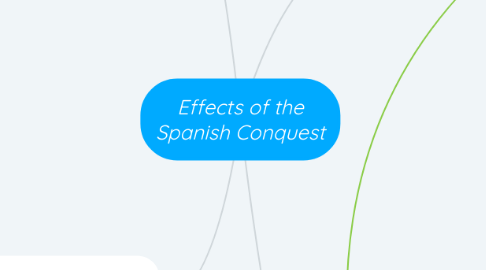Effects of the Spanish Conquest
作者:Felicia Tong


1. Destruction of Tenochtitlan
1.1. WHAT HAPPENED? The Destruction of Tenochtitlan was the event that followed the siege where the city of Tenochtitlan was levelled.
1.2. SHORT-TERM EFFECTS With the fall of Tenochtitlan, the Spanish continued to conquer more land. They were helped enormously by two factors: The first was from traditional enemies of the Aztecs. Cortés had already enlisted the enthusiastic help of the Tlaxcalans. Other local communities were also happy to see the back of them and free themselves from heavy tribute and the systematic capture. The second
1.3. LONG-TERM EFFECTS The Spanish had completely flattened Tenochtitlan to decimate the last of the Aztecs and they used this land for their own settlement.
1.4. MAKING LINKS The Destruction of Tenochtitlan made the colonisation of the Spanish possible.
2. The Colombian Exchange
2.1. Colombian Exchange Definition
2.1.1. Exchange= To swap or trade.
2.1.2. WHAT HAPPENED? The Colombian Exchange, otherwise known as the Colombian Interchange, was the widespread transfer of plants, animals, culture, populations, technology, and ideas between the Americas and the Old World. It began because Christopher Columbus "discovered" the New World and several other Europeans then followed in his footsteps.
2.1.3. Columbian= The period of time when Christopher Columbus was exploring.
2.2. SHORT-TERM EFFECTS The Spanish Conquest in the Americas resulted from Columbus' discovery of the New World. The Columbian Exchange was responsible for the spread of smallpox and other diseases into the Americas. Smallpox specifically killed approximately 90% of the original indigenous population.
2.3. LONG-TERM EFFECTS Although the Colombian Exchange brought illness and death through diseases at first, the trading and introduction of new crops and forms of food increased the population of the world, rather than decreasing.
2.4. MAKING LINKS The Colombian Exchange resulted in the spread of diseases.
3. Loss of population
4. Increasing population
5. Import of slaves- migration
6. Need for cheap labour
7. Exploration of the Americas
8. Extended settlement of the Old World
9. Bilbiography
10. Ancient.eu: Cortes & the Fall of the Aztec Empire Accessed 06/09/2018 https://www.ancient.eu/article/916/cortes--the-fall-of-the-aztec-empire/ New World Encyclopedia: Battle of Tenochtitlan, Both Sides Attempt to Recover Accessed 06/09/2018 http://www.newworldencyclopedia.org/entry/Battle_of_Tenochtitlan Oxford Digital Big Ideas: Humanities 8; by Easton, M. et al in 2016 Accessed 07/09/2018 Wikipedia: Fall of Tenochtitlan Accessed 06/09/2018 https://en.wikipedia.org/wiki/Fall_of_Tenochtitlan#The_surrender
11. Spread of diseases
11.1. WHAT HAPPENED? The Colombian Exchange had introduced several new diseases that were unknown to the American population. These diseases had evolved from their simpler forms and became more aggressive. The interchange of diseases between animals and humans develop the sicknesses and for anybody who was not immune, it was fatal.
11.1.1. EXAMPLE: The lifestyles of Europeans were very closely involved with animals- eg. farming and house pets. They came into daily contact with cows, horses, sheep, etc. The Americans, however, only lived closely with dogs.
11.2. SHORT-TERM EFFECTS Illnesses such as smallpox, measles, chickenpox, influenza, bubonic plague, whooping cough and many more were transferred from person to person. Having already been developed due to animal-human relationships in the Old World, they were practically unbeatable for the Aztecs, whose bodies were not resistant enough to these particular illnesses. These fatal diseases weakened the population and this is one of the reasons why the Spanish were so sucessful.
11.3. LONG-TERM EFFECTS The effect of the spreading diseases could still be felt years after the Spanish Conquest. There were major outbreaks of smallpox and it has been estimated that the indigenous populations in the Spanish colonies dropped by around 75% between 1518 and the 1560s.
11.4. MAKING LINKS The spread of diseases significantly weakened the population, making the Siege of Tenochtitlan more effective.
11.4.1. Weakening of Aztec population
